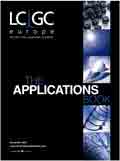Rapid Analysis of 303 Pesticide Residues in Green Bean Using Triple Quadrupole GC–MS–MS
Thermo Fisher Scientific Application Note
Chen Shubing,1 Yu Xuejun,1 Ye Fangting2 and Lu Ling,3
1Ningbo AQSIQ, Zhejiang, China, 2Thermo Fisher Scientific, Shanghai, China,
3Thermo Fisher Scientific, Austin, Texas, USA.
Introduction
As the number of pesticides increases and maximum residue levels (MRLs) decrease in regulations, the techniques used for GC-amenable pesticide residue analysis require that one sample be analysed using several injections with different methods to screen for hundreds of pesticides divided into the different groups.
Instrumentation/Equipment
A Thermo Scientific TriPlus liquid autosampler was used to inject a 1 μL aliquot of the final extract, using a hot needle injection. The sample was then separated using a 5% diphenyl/95% dimethyl polysiloxane, 30 m × 0.25 mm i.d., 0.25 μm film thickness column. The determination of 303 pesticides was carried out by the Thermo Scientific TSQ Quantum GC Triple Quadrupole Mass Spectrometer operated in timed-SRM mode. At least two SRM transitions for each pesticide and their collision energies were selected from the Thermo Scientific Pesticide Analyzer Reference. After a simple modification in an Excel file, the transitions can be imported directly to the instrument method.
Experimental Conditions
Sample preparation includes extraction, two steps of cleanup and solvent exchange according to the Chinese standard method GB/T 19648-2005. Matrix-matched calibration standards were prepared by spiking a mix of 303 pesticide standards into blank green bean and then followed by extraction for GC–MS–MS analysis. The final concentrations of standards in the matrix are 0.0040, 0.0100, 0.0200 and 0.0400 mg/kg. Five replicate QC samples at 0.010 mg/kg were also prepared under the same sample preparation procedure to evaluate average recovery and precision.
Results
The 303 pesticides, including various classes such as organochlorine, organophosphorus, carbamates and pyrethroids, were analysed in green bean by GC–MS–MS in 40 minutes, as shown in Figure 1. Because at least two transitions per each pesticide are required for the confirmation according to the European Council Directive 96/23/EC3, a total of 652 SRM transitions were acquired in one analytical run by the TSQ Quantum GC using timed-SRM mode. The timed-SRM function allows all 652 transitions to be set in many small overlapping windows based on the retention times of each pesticide. The dwell time of each transition was automatically maximized for each compound to give the best sensitivity for all pesticides in one run.

Figure 1: Total ion chromatogram demonstrating elution of 303 pesticides in 40 minutes.
The responses of SRM transitions were used for quantification analysis and the ratio of two SRM transitions for each compound were used for confirmation at the same time.
Calibration curves from 0.004–0.040 mg/kg were created using matrix-matched standard calibration solutions. The correlation coefficient (R2) for most pesticides was greater than 0.99. The signal-to-noise ratios for all 303 pesticides at lowest calibrated level were easily more than 10:1. The average recoveries for most pesticides at 0.010 mg/kg in matrix were within the range of 73–110%, with average precision of 10.3% CV.
Conclusion
The analysis of 303 pesticides in green bean was evaluated in one analytical run by using the TSQ Quantum GC, with 652 SRM transitions under timed-SRM mode. This analysis was used in combination with standard sample preparation including SPE as a clean-up procedure. Sensitivity can easily reach to 0.004 mg/kg for all pesticides in green bean. Linearity and recoveries at 0.010 mg/kg were within the requirements. Confirmations were demonstrated by using two SRM transitions for each pesticide with good stability of their ion ratios at different concentrations. Timed-SRM mode is the most effective method for screening and determining the large amounts of pesticides at low levels in the sample matrix. Furthermore, the instrument setup for hundreds of pesticide SRM transitions was simplified by using conditions given in the Pesticide Analyzer Reference, which minimized complex SRM method development work.
TSQ Quantum GC is a trademark of Thermo Fisher Scientific Inc and its subsidiaries.

Thermo Fisher Scientific Inc.
2215 Grand Avenue Parkway, Austin, Texas 78728, USA
tel. +1 800 532 4752 fax +1 561 688 8731
E-mail: analyze@thermoscientific.com
Website: www.thermoscientific.com

New Study Reviews Chromatography Methods for Flavonoid Analysis
April 21st 2025Flavonoids are widely used metabolites that carry out various functions in different industries, such as food and cosmetics. Detecting, separating, and quantifying them in fruit species can be a complicated process.
Analytical Challenges in Measuring Migration from Food Contact Materials
November 2nd 2015Food contact materials contain low molecular weight additives and processing aids which can migrate into foods leading to trace levels of contamination. Food safety is ensured through regulations, comprising compositional controls and migration limits, which present a significant analytical challenge to the food industry to ensure compliance and demonstrate due diligence. Of the various analytical approaches, LC-MS/MS has proved to be an essential tool in monitoring migration of target compounds into foods, and more sophisticated approaches such as LC-high resolution MS (Orbitrap) are being increasingly used for untargeted analysis to monitor non-intentionally added substances. This podcast will provide an overview to this area, illustrated with various applications showing current approaches being employed.

.png&w=3840&q=75)

.png&w=3840&q=75)



.png&w=3840&q=75)



.png&w=3840&q=75)












